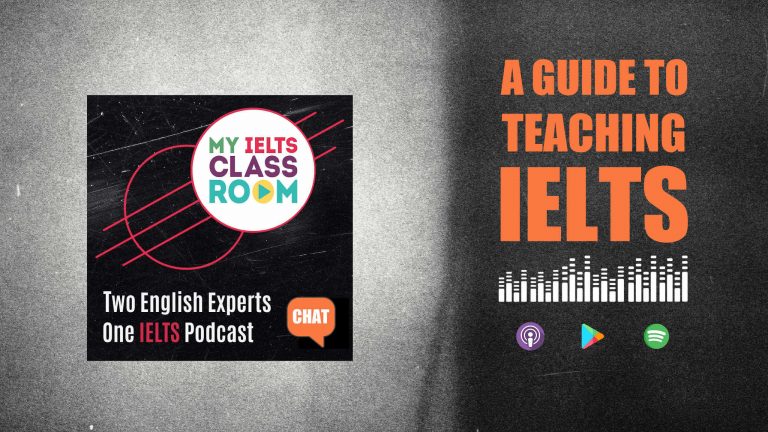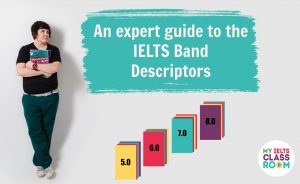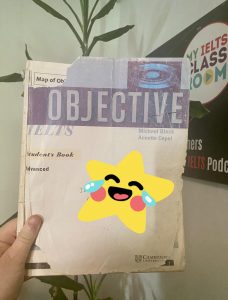
How to teach IELTS
Nothing is more rewarding as a teacher than working with an exam class that is motivated to learn and improve. In fact, as a former hockey player, I often compare the feeling to that of coaching a sports team – with the students being my athletes who are working together to defeat the “enemy” of IELTS (actually, that makes it sound more like war than a sports game, but you get the idea!) However, when are you ready as a teacher to start teaching exam classes? And, more importantly, once you are ready how do you start planning your classes? There is no one way how to teach IELTS, but in today’s podcast, Nick and I go through the basics that can help you start. Then, before you know it, you will have your own “IELTS team” up and running!
Below, you can find a summary of the episode, which includes all of the links to useful materials and the times of each part of the discussion (so you can go directly to the part you want to listen to) 🚀
Subscribe to My IELTS Classroom podcast on Apple podcasts here
Subscribe to My IELTS Classroom on Google podcasts here
Want to know how the examiner will apply the band descriptors when marking your IELTS essay?
Then download a copy of our FREE e-book, which explains how each of the four marking criteria is applied and includes the most common errors made by test-takers. Just click here for your copy.

Introduction – Shelly is moving back to the UK
I am moving back to the UK next month after spending 10 years living in Russia. That means I have spent the last 2 weeks going through all of my teaching materials deciding which to keep and which to recycle. Obviously, I would like to keep them all, but 13 A4 folders would fill up about four suitcases and with everything now online, there really is no need to keep thousands of small cut up pieces of paper (if you are a teacher, you will know!)
Going through all of my old lesson plans has been very nostalgic. Some lessons I haven’t taught for years, but just looking at my detailed notes took me right back to each classroom as if it was yesterday. I can’t get over how neat my handwriting was (I mean, who writes by hand now?!) and the amount of detail I went into for each stage of the lesson is astonishing. I am proud of young teacher me!

In fact, it was this process of looking through my old teaching notes that inspired today’s podcast episode. While sifting through six folders of IELTS notes and lesson plans, I could see the beginnings of My IELTS Classroom, and all the steps that I had taken to get where I am today – running an international school online. The journey hasn’t been a quick one, but it has been immensely rewarding. That’s why I would strongly encourage any qualified teacher who likes teaching structured classes to hop on the IELTS train.
Yes, there is a lot of misinformation online about the exam. Yes, there is a lot to learn at first. Yes it can sometimes feel like you battling the tidal wave of poor information online. But I promise that there is no feeling like guiding a student to a successful score in an exam that changes their life.
So, what are you waiting for? Let’s find out how to teach IELTS!
Are you ready to teach IELTS?
The first question every potential IELTS teacher needs to ask themselves is
Am I really ready to take the responsibility of guiding a student to take an exam that is both expensive and life changing?
I really ask you to sit with this question for a few moments as it seems to me that there are a lot of people who consider becoming an “IELTS teacher” because they “did well” in the test themselves, or (worse) who think that “IELTS pays well”, so they will it a go. Neither of these are good reasons to become an IELTS teacher.
I have had quite difficult conversations with some of my previous students who finally managed to get a 7.0 in writing after 10 attempts (only the last one was with me!) and then turned around and announced to me that they were now “coaching students” in their home countries.
Honestly, I find this behaviour shocking! These are people who less than a month ago were struggling to get the basics of essay writing right (and it always is writing that these overnight tutors want to offer help with), and now they are creating websites and YouTube channels as if they are experts.
I always think of these “tutors” like people who pass their driving test in the morning and then set out as instructors in the afternoon!
The situation is so ludicrous that it would be funny if the consequences of such actions were not so serious. However, I don’t want you to think that it is only non-native “teachers” who do this. I know plenty of native speakers who have taught exam courses without any basic knowledge of what the IELTS exam actually involved.

The truth is that only you can know if you are really ready to teach IELTS or not. My advice, though, would be to make sure that you have a genuine teaching qualification like a CELTA and to wait until you have 2 or 3 years teaching experience under your belt before you consider IELTS. Many teachers find starting with lower stakes Cambridge exams like FCE or PET a good place to start.
If you are a native speaker, working through some of the Cambridge books will help you fully understand the difficulties that your potential students will face and whether or not you feel equipped enough to help them deal with them. I have some friends who would rather cut off their arm with a blunt knife than have to teach academic English (that is my metaphor not theirs!)
If you are non-native speaker, consider taking the exam yourself before you teach it so that you fully understand what it involves. Your score will also be a good indication if you are ready to guide others or not. Plus, if you do really well, it can act as an advert for future students (as our past student Anna described in our recent interview).
Planning a class
Once you feel ready and excited to take on the challenges of teaching IELTS, the next question is obviously:
How will you structure your IELTS course?
This will depend greatly on a number of factors that are outside your control, including:
- Time: How many weeks will you have to teach the course? Will there be 20 lessons or 10? The time you have to cover the material may be the most influential factor in how you structure the course. We would all like 100+ hours to prepare our students, but if you only have 10 that will really affect the depth you can go into in each class.
- Level: What scores are your students aiming for? A class whose students all need a 5.5 to enter university will look very different to one in which everybody is aiming for a 7.0 or higher!
- Age: Are you working with teenagers who may prefer a more kinaesthetic approach, or are you working with people who are coming to class after a long day at work and are tired and want to get straight down to business?
- Language: Are you teaching a mono-lingual class who are likely to have the same problem areas, or are your students from different counties and each have their own struggles?
However, the main decision you will need to make is whether you want to structure your classes to be integrated (i.e. to cover multiple skills in one lesson, usually under the umbrella of one “topic”) or to focus on one skill per lesson (i.e. to single out reading, listening, writing or speaking in each lesson).
There are benefits and drawbacks to each approach (which we discuss in the podcast), but if you are planning to teach one group for an extended period of time, I would strongly recommend that you choose an integrated approach. In my opinion, these are much more interesting for students (and teachers!) and it is easier to retain student attention for extended periods of time if the tasks change every 30 minutes or so!
Want to see what a well-planned IELTS course and lessons look like? Then why not consider joining in our Bronze Writing Package. This will give you access to all of our teaching materials for 31 days (including our daily live lessons), and has been the starting point for many IELTS teachers. Find out more here

What to teach
Next, there is the question of which materials you will actually use in your class. Unfortunately, there is no one answer to this question. IELTS does provide an official curriculum, and there are literally hundreds of IELTS text books on the market, many of which print conflicting information. I wish that I could recommend one particular book that you could confidently use in class, but the truth is that there is no one that covers all parts of the exam perfectly.
However, what I can recommend is that you start with books that are published by Cambridge, MacMillan, Collins or Oxford University Press.
Titles like Focus on IELTS, Objective IELTS, or IELTS Masterclass are all great places to start, and you can be sure that any information printed in books from these publishers is 100% accurate and the teachers’ books that accompany them will offer great guidance, especially for those starting their IELTS teaching career.

Obviously, you will not want to stick to one book even if you have an official “course book” that your students buy (or find for free online and use on their iPads!). Good teachers are those who supplement with materials from other sources, or with those that they have made themselves. There are a number of good teachers’ resource packs for IELTS – my favourite was always “Instant IELTS”.
If you decide to mix and match between books so that you can set your own curriculum (which is what you should be moving towards) then consider the order in which you present information to your students:
- Start with the question types that are most common in the exam i.e. in reading, start the course with T/F/NG, or for writing Discuss Both Sides or Agree / Disagree essays. This is particularly important if you have a very short course as you may have to sacrifice some question types. I am thinking, for example, of processes and maps in Academic Writing Task One, which are less common and might be mentioned briefly at the end of the course once the more common change and compare charts have been covered.
- Also cover the question types that require specific training near the start of the course: most students will have encountered multiple choice questions before at school, but not many will have tackled Headings Match or Information match Writing before. Going through these at the start of the course will give the students time to acquire these new skills, and you time to go back to them later if you feel they need more practice.
- Build skills from the foundation up: Using Academic English will be a new skill for many students, especially if your students are from a culture where less emphasis is put on the written testing. Start slow and assume that your students know nothing. Thinking about the most logical way that you can present skills to your students will elevate your teaching. In exam writing class, for example, start with the foundational skills like generating ideas, organising paragraphs, and writing introductions, conclusions and topic sentences, and then move on to more complex skills like building paragraphs, hedging, and referencing.
- Give clear tactics and methods to tackle each part of the test: I have noticed a sad trend that most teachers view the receptive skill as just “somatic that can be done at home”. This is not true – just as many students miss out on their target scores because of reading or listening than speaking or writing. If your “help” for reading, for example, is just telling students to “scan”, you are not actually teaching them (and my guess is that you have not followed my earlier advice and done the exam yourself – if you had, you would realise that this does not work!)
- Make your classes interactive: Nobody wants to sit in a classroom listening to a teacher talking and talking. Students learn by doing! Make your classes as interactive as possible. You may think that IELTS is “dry” but I think that it offers endless opportunities for communicative tasks. Listen to the episode for my examples of how to spice up Coherence and Cohesion lessons!
- Give clear feedback at every stage: Your job as a teacher is letting students know how well they are progressing. For writing and speaking, that means getting to grips with the band descriptors. In fact, this should be the first place you should look before planning your course as these will be the standards against which your students will be marked.
How to keep on improving
Let’s be honest – your first IELTS course will not be perfect! In fact, I am pretty confident that you will be happy when it ends and grateful for some time to rest and reflect before the next one starts. However, that is fine! The mark of a good teacher is one who is always trying to improve their courses. You will know which parts of the course went well, and which fell flat, so now is the time to look back and change your lesson plans.
More importantly, keep in touch with your students and find out what scores they got in the exam!
This is the absolute best way that you can find out if your teaching was on point or if there are parts of our curriculum you need to strengthen. If all of your students score well in listening but got got lower scores in writing, then you will know to focus more on this skill in the next course.

This may be the time to sign up to some teacher training modules or to reach out to a more experienced colleague for help and advice. We are about to start a series of teacher training courses, so if you are interested, email me at hello@myieltsclassroom.com to add your name to the waiting list.
The main thing is that you have started your journey to becoming a good IELTS teacher – it may not be an easy job, but if you can shoulder the responsibility it is the most rewarding one that I know.
